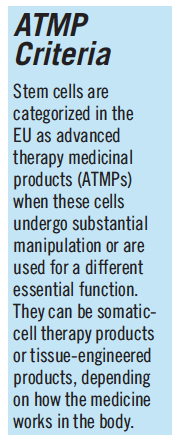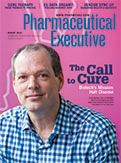Gene Therapy: How ‘Advanced’ is Europe?
Exploring the EU’s struggles and new efforts in promoting cell and gene drugs.
Chronicling the EU’s past struggles and new efforts in promoting gene therapies, known in Europe as advanced therapy medicinal products
In Europe, legislation relating to medicines based on genes, tissues, or cells dates back nearly 20 years, and was reinforced by specific European Union regulation that came fully into effect nearly a decade ago-but still today there are only a tiny handful of these products on the market.
This limited outcome belies years of extensive and intensive activity among drug developers and regulators: between 2009 and 2017, 500 clinical trials are recorded with products of this type (known in European terminology as ATMPs-advanced therapy medicinal products). But all of this resulted in only 19 market authorization applications to the European Medicines Agency (EMA), and only 10 ATMPs received a marketing authorization. In addition, three companies later withdrew their product, and one discontinued product marketing, all citing commercial reasons, according to the most recent published survey conducted among companies. The latest official EU figures also show that the EMA’s first recommendation for approval of an ATMP containing stem cells was issued only in 2014, and since then there was one more in 2015, two in 2016 and two in 2017, and three in 2018: Kymriah and Yescarta, the first two CAR T- cell therapies in the EU, and Luxturna, for inherited retinal dystrophy caused by RPE65 gene mutations.
The slow progress does not derive uniquely from a lack of legislation or regulatory guidance.
No shortage of regulation
The EU’s specific legislation classifies further into three main types: gene therapy medicines, somatic-cell

therapy medicines, and tissue-engineered medicines. In addition, “combined” ATMPs may contain one or more medical devices as an integral part of the drug, such as cells embedded in a biodegradable matrix or scaffold (detailed definitions are set out in Regulation (EC) No 1394/2007).
Since 2011, the EU’s centralized authorization procedure has been adapted with defined and customized technical requirements, and specific and strict requirements relating to risk management and traceability (including retaining data for a minimum of 30 years after product expiry). EMA conducts the single evaluation and authorization procedure, and continues to monitor their safety and efficacy. A specialist Committee for Advanced Therapies (CAT) provides the scientific assessment. It delivers a draft opinion on a product’s quality, safety, and efficacy and transmits it to the EMA’s Committee for Medicinal Products for Human Use (CHMP), EMA’s main scientific body, which produces a recommendation as the basis for the European Commission to make the final decision.
Easing market access?
In addition to its obvious intention of guaranteeing the highest level of health protection for patients, the EU legislation was designed explicitly to ease access to the entire EU market, to ensure wide availability of approved products, and to promote the competitiveness of European companies in the field.
But an official review of the ATMP regulation in 2014 concluded that while it had protected patients from unsound treatments, it found shortcomings across manufacturing, early and later phases of development, the marketing authorization process, and the postmarketing setting.
The EU response was to confirm that it was committed to supporting the development of ATMPs and was determined to “ensure that the regulatory framework supports-and not hinders” their development. This response took concrete shape with an EU action plan agreed in 2017, aimed at streamlining procedures and meeting developers’ specific requirements more smartly. The plan was updated in April and again in November 2018.
Efforts have also been made by regulators to reduce administrative burdens and adapt manufacturing requirements to the specific characteristics of ATMPs: a specific GMP framework for ATMPs was created, and EMA has organized specific training sessions for national inspectors to align their approaches. An updated guideline on “Quality, preclinical and clinical aspects of gene therapy medicinal products (EMA/CAT/80183/2014)” was published in 2018. And development of a guideline on quality, non-clinical, and clinical requirements for applications for clinical trials for ATMPs has been underway for more than a year now, and is due for finalization by late 2019. An updated guideline on “Quality, non-clinical and clinical aspects of medicinal products containing genetically modified cells (CHMP/GTWP/671639/2008)” was released for public consultation in July 2018 for a period of one year, with the aim of helping to clarify regulatory expectations. The aim is to finalize this revision in late 2019 as well.
Adapted guidance on Good Laboratory Practice for ATMPs has also been developed to help in approval of clinical trials or granting of marketing authorization in cases where GLP-compliant preclinical studies are not feasible. And an EMA Q&A on the risk-based approach for ATMPs that have not been subject to substantial manipulation was published in 2017 to explain how this can provide flexibility and reduce requirements in a marketing authorization application depending on specific risks.
Last year also saw an update to the procedural advice on evaluation and a draft revised guideline on safety and efficacy follow-up and risk management.

But work on more than 100 guidance documents had to be put on hold as EMA prepared for Brexit-including the guideline on the comparability for ATMPs, which will address a recurrent issue for almost all ATMP developments where manufacturing changes take place during the product development.
Practical assistance
In parallel to the evolution of regulation and guidance, there is plenty of work among regulators aimed at assisting the emergence of ATMPs.
EMA increasingly gives scientific support to developers in designing pharmacovigilance and risk management systems for ATMPs, through early dialogue with multidisciplinary or multi-stakeholder expert teams. EMA procedures for scientific advice are also being streamlined, including by strengthening interaction between EMA’s committees with responsibilities for ATMPs. And increased interaction between EMA and EUnetHTA is underway on product evaluation, to increase understanding of health technology assessment, regulatory processes, and clinical-added value of ATMPs.
ATMPs are constantly on the agenda of the EMA-linked Innovation Task Force, a scientific, regulatory, and legal forum for early dialogue with applicants. The legislation also created incentives, including fee reductions for scientific advice and for marketing authorization, with particular significance for smaller firms and for hospitals.
Advanced therapies feature in the latest call for proposals under the EU’s Innovative Medicines Initiative public-private research program, with €45 million offered in support for projects that accelerate research into advanced therapies for rare diseases, or support the development of engineered T-cells to fight cancer. The funding is a recognition that “developing ATMPs is highly challenging,” said the announcement in late June. The specific aim is to advance understanding of the factors that trigger an immune response to ATMPs, and develop tools to study them. Regulators will also be involved, to ensure the tools and data generated by the project are in line with their expectations and needs for assessment. The focus will be on rare diseases caused by a single gene mutation, although it is expected that many of the project’s findings will be applicable to other diseases.
ATMPs feature prominently in the reinforced EU-US collaboration on medicines, with senior officials from the Commission, EMA, and FDA acknowledging the “similar regulatory challenges on both sides of the Atlantic,” and agreeing to encourage early parallel scientific advice and to strengthen collaboration on common scientific approaches on regulation.
Unfulfilled potential?
EMA’s own recently published regulatory strategy for 2025 spells the dilemma out clearly. It identifies cell-based therapies at the top of the list of the “transformational research that is having a significant impact on the regulatory science agenda.” ATMPs “have great potential to address unmet medical need,” it goes on.
But “the number of applications for approval has been, however, very limited,” it remarks, and “despite ongoing efforts in this area, more remains to be done to address current challenges and those that will rise from emerging technological advances in the ATMP field.”
It is work in progress in Europe-but a lot of work lies ahead.
Reflector is Pharmaceutical Executive’s correspondent in Brussels

Addressing Disparities in Psoriasis Trials: Takeda's Strategies for Inclusivity in Clinical Research
April 14th 2025LaShell Robinson, Head of Global Feasibility and Trial Equity at Takeda, speaks about the company's strategies to engage patients in underrepresented populations in its phase III psoriasis trials.